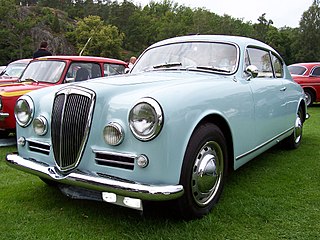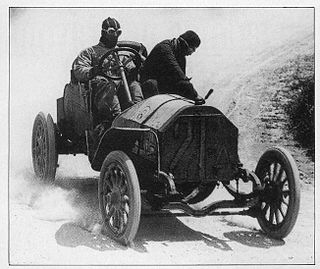| Enrico Anselmi | |||||||||||
|---|---|---|---|---|---|---|---|---|---|---|---|
 Enrico driving a Lancia Aurelia B20 at 1953 Mille Miglia to 7th place | |||||||||||
| Nationality | | ||||||||||
| Born | Enrico Anselmi | ||||||||||
| |||||||||||
Enrico Anselmi was an Italian racing driver, who made a name for himself racing Lancias in the early 1950s.
| Enrico Anselmi | |||||||||||
|---|---|---|---|---|---|---|---|---|---|---|---|
 Enrico driving a Lancia Aurelia B20 at 1953 Mille Miglia to 7th place | |||||||||||
| Nationality | | ||||||||||
| Born | Enrico Anselmi | ||||||||||
| |||||||||||
Enrico Anselmi was an Italian racing driver, who made a name for himself racing Lancias in the early 1950s.
Enrico Anselmi, raced internationally, primarily in sportscars between 1947 and 1957, mainly in Lancia Aprilias and Lancia Aurelias. In 1952, his big break came when Scuderia Lancia offer him the chance to drive a works Aurelia in les 24 Heures de Mans, where partnered Felice Bonetto to eighth place overall. [1] [2]
During this period, he enjoyed some success, scoring his only race win, in the 1951 non-championship Coppa d'Oro delle Dolomiti and finished second in the 6 Ore di Pescara. In addition, he also won his class on the Mille Miglia that season. He repeated this feat the following season and claimed another class win. Away from Sportscars, Enrico raced in just one Formula Two race, the 1951 Gran Premio del V Centenario Colombiano, but retired his Ferrari 166. In the 1952 Targa Florio, he finished third, in the year; the Aurelia occupied the whole podium of the famous Sicilian competition. [1] [3] [4] [5] [6]
After finishing 1st and 3rd at the 1957 Coppa Inter-Europa, held at the Autodromo Nazionale Monza, in the GT1.1 and GT2.6 classes respectively, he would retire from International Motor Sport. [1]
| Season | Series | Position | Team | Car |
|---|---|---|---|---|
| 1951 | Coppa d'Oro delle Dolomiti [7] | 1st | Lancia Aurelia B20 | |
| 6 Ore di Pescara [8] | 2nd | Lancia Aurelia | ||
| 1952 | Targa Florio [9] | 3rd | Lancia Aurelia B20 Competizione | |
| 1953 | Giro delle Calabria [10] | 3rd | Lancia Aurelia 2500 GT |
| Year | Team | Co-Drivers | Car | Class | Laps | Pos. | Class Pos. |
|---|---|---|---|---|---|---|---|
| 1952 | | | Lancia Aurelia B20 | S2.0 | 247 | 8th | 2nd |
| Year | Team | Co-Drivers | Car | Class | Pos. | Class Pos. |
|---|---|---|---|---|---|---|
| 1947 | | Fiat | S2.0 | 19th | 2nd | |
| 1948 | | Fiat 1100 | S1.1 | 11th | 8th | |
| 1950 | | Lancia Aprilia | T+1.1 | 27th | 4th | |
| 1951 | | Lancia Aprilia | VU1.5 | 24th | 1st | |
| 1952 | | Lancia Aurelia B20 | GT2.0 | 5th | 1st | |
| 1953 | Scuderia Lancia | | Lancia Aurelia B20 | S+2.0 | 7th | 6th |
| 1954 | Lancia Aurelia B20 | S+2.0 | DNF | |||
| 1957 | Lancia Appia GT Zagato | GT1.1 | 54th | 2nd | ||

A grand tourer (GT) is a type of sports car that is designed for high speed and long-distance driving, due to a combination of performance and luxury attributes. The most common format is a front-engine, rear-wheel-drive two-door coupé with either a two-seat or a 2+2 arrangement. Grand tourers are most often the coupé derivative of luxury saloons.

The Targa Florio was an open road endurance automobile race held in the mountains of Sicily near the island's capital of Palermo. Founded in 1906, it was the oldest sports car racing event, part of the World Sportscar Championship between 1955 and 1973. While the first races consisted of a whole tour of the island, the track length in the race's last decades was limited to the 72 kilometres (45 mi) of the Circuito Piccolo delle Madonie, which was lapped 11 times.

Peter John Collins was a British racing driver. He was killed in the 1958 German Grand Prix, just weeks after winning the RAC British Grand Prix. He started his career as a 17-year-old in 1949, impressing in Formula 3 races, finishing third in the 1951 Autosport National Formula 3 Championship.

Clemente Biondetti was an Italian auto racing driver. Born into a working-class family, Biondetti raced motorcycles before turning to automobiles where he had greater success.

Felice Bonetto was a courageous racing driver who earned the nickname Il Pirata.

Umberto Maglioli was a racing driver from Italy. He participated in 10 Formula One World Championship Grands Prix, debuting on 13 September 1953. He achieved 2 podiums, and scored a total of 3 1⁄3 championship points. He participated in the Targa Florio race nineteen times, winning it three times, and the Mille Miglia ten times, with the best result being a second place in the Lancia Aurelia B20 GT in 1951.

Giuseppe Campari was an Italian opera singer and Grand Prix motor racing driver.

The Ferrari 195 S was a sports racing car produced by Ferrari in 1950. It was an improved version of the 166 MM. The 195 S won Mille Miglia, Coppa della Toscana and Giro delle Calabria.

The Ferrari 250 S was a sports racing car produced by Ferrari in 1952. It was the first in the long lineage of Ferrari 250 road and race cars powered by an ubiquitous 3.0-litre Colombo V12 engine. In 1952 the 250 S won the Mille Miglia and 12 Hours of Pescara. At the Le Mans, the same year, it clocked the fastest race lap time. Only a single example was produced.

The Ferrari 225 S was a sports racing car produced by Ferrari in 1952. It was an evolution over the preceding Ferrari 212 Export with important engine upgrades that greatly improved power output. The model was extensively used in competition, winning many international races. The most important include 1952 Monaco Grand Prix for sports cars, Portuguese Grand Prix, Coppa d'Oro di Sicilia, Coppa della Toscana, Coppa d'Oro delle Dolomiti and many others. It was the final Colombo V12 engine iteration before the 250-family stretched it to 3.0-litres capacity.
The 1955 World Sportscar Championship season was the third season of FIA World Sportscar Championship motor racing. It featured a series of six endurance races for sportscars, contested from 23 January to 16 October 1954.

The Ferrari 212 Export was a sports racing car produced by Ferrari in 1951–1952. The 212 Exports won Tour de France automobile, Giro di Sicilia, Coppa della Toscana, 10 Hours of Messina and other motor races throughout its career. It was meant to be a sports car available for oversea markets.

Enrico Nardi was an Italian racing car driver, engineer and designer.

Count Giannino Marzotto was an Italian racing driver and entrepreneur. Marzotto served as President of the Mille Miglia Club, and twice winner of race in 1950 and 1953.
Emilio Giletti was an Italian racing driver. He made a name for himself in the early 1950s, after the racing experience took possession of the family factory, and was later the owner of Giletti S.p.A. His son Massimo Giletti is an Italian television host.

Luigi "Gino" Valenzano was an Italian racing driver. He entered 39 races between 1947 and 1955 in Abarths, Maseratis and Lancias as a teammate of drivers like Robert Manzon and Froilán González.

The Dolomites Gold Cup Race was a car race on public roads open to traffic, which was run in the Dolomite Mountains of northern Italy for ten years from 1947 to 1956. It took place along an anti-clockwise circuit that was 304 km long and usually took about 3 to 4 hours to complete the one lap that made up the race distance, with the start and finish in the town of Cortina d'Ampezzo. The circuit went through many Italian towns, and it had nearly 2,000 meters of elevation change- more than 6 1/2 times that of the Nürburgring and the Isle of Man TT track. It was established by the Automobile Club of Belluno, which is still the runner of the now historic event, since 1972. The race is included in the international calendar FIA as "Big Event CSAI" classic regularity.
The 42° Targa Florio took place on 11 May, on the Circuito Piccolo delle Madonie,. It was the third round of the 1958 World Sportscar Championship, which was running to new regulations introduced at the beginning of the season. The most influential of these regulations changes would be the 3.0 litre engine size limit. The event returned to the championship for the first time since 1955, following the demise of the Mille Miglia and the ban on road racing on mainland Italy. But such outcry did not deter Vincenzo Florio from holding his event on the traditional 45 mile mountainous circuit.

The Ferrari 250 MM was a sports racing car produced by Ferrari in 1953. After the initial racing successes of the 3.0-litre Colombo V12 engine, introduced in the 250 S one-off, Ferrari produced a serial racing model. It is best recognisable for the distinctive closed berlinetta bodywork by Pinin Farina. The "MM" in its name stood for the Mille Miglia race.

Coppa della Toscana was a sports car race held on the roads of Tuscany, through Livorno and Florence, between 1949 and 1954.
| Sporting positions | ||
|---|---|---|
| Preceded by Giannino Marzotto | Coppa d’Oro delle Dolomiti 1951 | Succeeded by Paolo Marzotto |